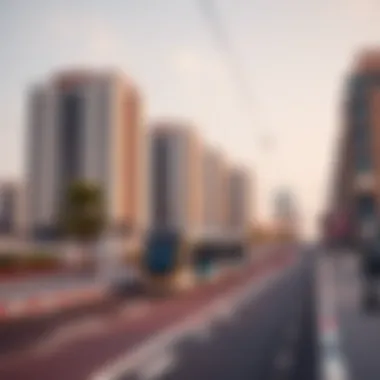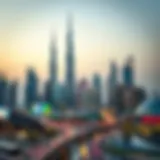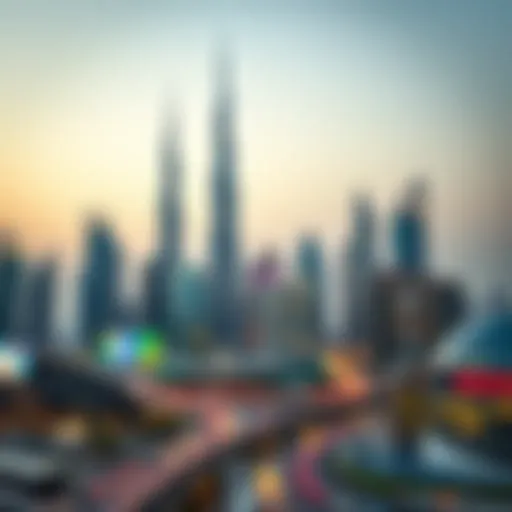Exploring the Dubai Metro and Tram Network


Intro
Dubai, a city that almost seems painted by an artist's hand, has transformed itself over the years into a bustling metropolis known for its skyline, luxury, and innovation. Among the many marvels that dot its landscape, the Dubai Metro and Tram network stand out as pivotal players in the urban development narrative. This intricate web of rails and stations doesn’t just offer commuters a means of transportation; it symbolizes the modernization and forward thinking that drives the UAE.
As we peel back the layers of this extensive system, you'll find more than mere routes and stops. The Metro and Tram network is a testament to how public transport can influence real estate and the overall socio-economic framework of a city. The ease of connectivity enhances property values, making areas served by these transit options particularly attractive to potential buyers and investors.
But the story doesn’t end with just transportation. Understanding the dynamics at play within the real estate market connected to this network is crucial for investors, homeowners, and expatriates alike. This guide serves as your compass, navigating through the complex pathways of the Dubai Metro and Tram, while also shedding light on the market insights and investment guidance relevant to anyone looking to get their foot in the door of Dubai’s vibrant property scene.
As we move forward, expect a detailed exploration of key trends in the real estate market, insights into property prices and forecasts, and practical tips designed to help first-time buyers and seasoned investors make informed decisions.
Stay tuned as we embark on this journey to uncover the operational efficiency and connectivity that not only makes commuting a breeze but also fuels the flames of property investment in one of the fastest-growing cities in the world.
Overview of the Transportation Landscape in Dubai
Dubai boasts a transportation landscape that is as vibrant and dynamic as the city itself. In this article’s context, delineating the features and nuances of public transportation, particularly the Metro and Tram systems, offers insight into how these amenities shape urban life. With a growing population and a surge in tourism, getting from point A to point B efficiently is no longer a luxury; it’s a necessity.
Public Transportation in Urban Development
Public transportation is at the core of urban development in Dubai. The city’s infrastructure has evolved significantly over the past decades, largely in response to the burgeoning demand created by a diverse resident populace and an influx of tourists. A well-functioning public transport system facilitates easier access to various neighborhoods, commercial centers, and tourist attractions, cutting down on traffic congestion and lowering the carbon footprint.
The convenience of a reliable transport network fosters a livable environment where people can move freely without relying entirely on personal vehicles. Moreover, there are a plethora of benefits associated with robust public transportation:
- Economic Efficiency: Affordability of fares makes commuting feasible for all socio-economic groups.
- Accessibility: Typically, public transport systems in Dubai are designed to be accessible to individuals with disabilities, ensuring inclusivity.
- Cultural Exchange: For expatriates and tourists, public transport offers a glimpse into the local culture and everyday life in Dubai.
Role of Metro and Tram Systems
The role of the Metro and Tram systems is integral to the cohesive framework of Dubai's public transportation. Established to link major suburban areas with the city’s bustling heart, these systems are crucial in managing the population's movements across the vast metropolis.
The Dubai Metro, with its visually stunning stations and efficient service, operates high above the congestion, while the Tram system runs along the prestigious Al Sufouh Road, connecting key neighborhoods such as Dubai Marina. Together, they form a seamless network that significantly mitigates travel times.
Some notable characteristics include:
- Innovation in Design: The Metro stations showcase modern architectural designs, representing the city’s image as a global hub.
- Technology Integration: Smart ticketing and real-time tracking enhance user experience by providing vital information to commuters.
- Environmental Considerations: Both systems utilize energy-efficient technologies, contributing to Dubai's sustainable objectives.
In summary, the transportation landscape in Dubai is ever-evolving, facilitating urban growth while promoting connectivity. Understanding this foundation sets the tone for exploring the operational aspects of the Metro and Tram systems throughout this article.
Dubai Metro: An Engineering Marvel
The Dubai Metro stands tall as a significant achievement in urban transportation, reflecting the ambition and innovative spirit of the city. It's not merely a means of getting from point A to point B; it's an engineering feat that has reshaped how residents and tourists interact with Dubai. Understanding the intricacies of the Metro system is vital for anyone looking to navigate this vibrant metropolis, especially investors and potential homeowners. The Metro's efficiency and reach can directly influence property values and accessibility, making it a crucial consideration in the real estate landscape.
History and Development
The origins of the Dubai Metro can be traced back to the early 2000s when the city was experiencing rapid growth and development. The Dubai government recognized the pressing need for a robust public transportation system to reduce traffic congestion and improve air quality. With an investment that soared into billions, the project kicked off in 2005.
Leadership from expert engineers and architects worldwide combined to bring the vision to life. Construction began in earnest, and the first line was officially opened in 2009. Since then, the Metro has expanded to cover over 75 kilometers, connecting key commercial, residential, and touristic hubs. This project not only exemplifies cutting-edge technology but also showcases a commitment to sustainable urban development. The operational excellence of the Metro system is rooted in its design, which emphasizes efficiency and passenger comfort.


Route Map Analysis
Red Line Overview
The Red Line of the Dubai Metro is often viewed as the backbone of the system, stretching from Rashidiya to UAE Exchange. It’s the first line to be developed and holds a significant portion of the network's ridership. Spanning various key areas, the Red Line connects major landmarks, making it a popular choice among both commuters and tourists.
One of its standout characteristics is its elevated track design over considerable stretches, allowing for spectacular views of the cityscape. Furthermore, the line integrates seamlessly with the tram network, enhancing connectivity. A particular highlight is the ability to access Dubai International Airport, which sets the Red Line apart in terms of convenience. However, during peak hours, overcrowding can be a notable drawback, necessitating strategic planning for commuters.
Green Line Insights
The Green Line complements the Red Line by offering a crucial alternative route that runs from Etisalat to Creek. What makes this line particularly interesting is that it traverses through areas with diverse cultural representation and local businesses. This aspect enriches the commuting experience, drawing riders not just for transportation but for exploration.
One unique feature of the Green Line is its fully underground nature in certain sections, providing a shield from the sweltering Dubai heat. This factor enhances user comfort significantly, establishing it as a favorable option for daily commuters. Nevertheless, it’s essential to note that the frequency of trains, though acceptable, can sometimes be lower than that of the Red Line, impacting travel time during peak periods.
Future Expansions
The future of the Dubai Metro looks promising, with ongoing plans for further expansions. Key among the proposed projects is the extension of the metro lines to areas like Dubai World Central and other emerging districts. As the city continues to grow, these expansions aim to cater to an increasing population and promote sustainable living.
An important aspect of these expansions is their focus on integrating newer green technologies, aimed at minimizing the environmental footprint. The emphasis on crafting a more extensive network ensures that the Metro remains a pivotal player in Dubai's transportation future. However, securing funding and managing logistical challenges can pose risks to timely completion.
In summary, the Dubai Metro encapsulates advanced engineering principles and practical application in urban transport. By weaving an intricate network that benefits daily commuters and tourists alike, and addressing the real estate landscape's needs, it serves as a fundamental cornerstone of modern Dubai.
Dubai Tram: Enhancing Connectivity
The Dubai Tram is more than just another means of transport; it weaves through the urban fabric of Dubai, linking avenues filled with life and opportunity. This tram system stands as a testament to the city’s continuous evolution, enhancing the accessibility and mobility of residents and visitors alike. As times progress, it becomes increasingly crucial to understand how this tram network complements the bustling metro system, bridges communities, and stimulates local economies.
Operational Features
One of the standout characteristics of the Dubai Tram is its impressive operational features, which play an essential role in providing efficient public transport. The tram boasts a fleet of modern, fully air-conditioned vehicles designed to ensure comfort in the sweltering heat typical of the Emirates.
- Running Frequency: The trams operate every 10 to 12 minutes during peak hours, providing customers with a ready solution to their commuting needs. No one has to wait long to hop on a tram and be whisked away to their destination.
- Smart Technology: Integration of smart technology enhances the commuting experience. Passengers can monitor their trams in real-time via mobile applications, which offer updates on arrivals. This removes the age-old worry of missing a ride, ensuring added convenience.
- Safety Features: The safety standards employed are top-notch, with measures like CCTV surveillance, emergency alarms, and trained staff ensuring that each journey is as secure as it can be.
Even more impressive is the accessibility provided across the tram network. All stations are designed with ramps and tactile paving, making it easy for everyone, including those with mobility challenges, to make use of this transport.
Integration with the Metro
The integration of the Tram with the Dubai Metro system is a strategic move that sets Dubai apart from many other cities. The seamless connection between these transport services amplifies efficiency in urban mobility. Passengers often find it beneficial, as a single NOL card can be used for both systems, streamlining the fare process.
- Connectivity: There are several interchange stations where one can easily transfer from tram to metro and vice versa. This direct connection minimizes travel time and maximizes convenience, transforming how residents commute. One can start a journey on the Red Line, hop onto a tram, and reach their final stop without the need for time-consuming detours.
- Strategic Locations: The tram network links significant areas like Dubai Marina, Jumeirah Beach Residence, and Al Sufouh, enhancing not just mobility but also the potential for economic growth in these locales. With increased foot traffic, local businesses are benefitting, heightening the liveliness of these neighborhoods.
- Future Prospects: As urban planning evolves, more links and lines are expected to bridge the tram and metro further, giving rise to improved accessibility for all and reinforcing the symbiotic relationship between various transport systems.
In summary, the Dubai Tram doesn’t just provide a ride; it connects lives, advances economies, and supports the future of urban transport in Dubai. Whether you're a local looking to streamline your daily commute or an investor keen on spotting emerging trends in property value, understanding the tram system's role in the broader transportation landscape is invaluable.
"Public transport systems like the Tram represent the beating heart of urbanization in Dubai, playing a vital role in connecting neighborhoods and driving urban economies forward." - Analyst in Urban Studies
For further reading, you can explore resources like Wikipedia on Dubai Tram or visit official Dubai government portals to stay updated on developments.


User Experience and Accessibility
When we talk about the Dubai Metro and Tram system, user experience and accessibility really set the foundation for how effective the entire transportation network is. Whether you’re a local or a visitor, the usability of the system can significantly affect how you navigate the city. Thus, considerations regarding ease of use, ticketing, and station amenities become paramount, especially in a bustling metropolis like Dubai where time is often of the essence. For investors or anyone keen on residing in the area, understanding how these factors play into daily life can provide valuable insight about the urban landscape.
Ticketing and Fare Structure
Navigating the ticketing system can initially seem like a tall order. However, once you dip your toes into it, things shape up pretty fast. Various options such as single journey tickets, Nol cards, and monthly passes cater to different commuting habits. With single journey tickets, one can purchase a ticket for a specific trip on the Metro or Tram that’s valid for a limited time. On the other hand, Nol cards offer not just simplicity but also affordability. These cards can be topped up and they grant access across multiple modes of transport including buses and water taxis!
The pricing structure is straightforward, with different fare zones determining the cost. Each journey starts from a base fare, and it's no hidden treasure that longer distances come with a heavier price tag.
A little tip for beginners: it might help to plan your trips ahead and choose the fare type that fits your needs best. This way, you can save a bit of cash that could be utilized elsewhere.
Station Facilities
Diving into station facilities, there's quite a bit to unpack. The Metro and Tram stations are typically well-equipped to ensure comfort and convenience for commuters. Features like waiting areas, ticket machines, and information kiosks help in making the transit experience as seamless as possible.
Accessibility for People with Disabilities
The considerations for accessibility extend well beyond mere compliance; they reflect a comprehensive effort to create an inclusive environment. Platforms are designed with a keen focus on ensuring easy access for wheelchair users, with ramps and tactile guidance systems. Elevators are available at most stations, making transitions smooth and eliminating the hassle of navigating stairs.
Additionally, information displays are clear and multilingual, catering to the diverse population of Dubai. All these characteristics not only enhance the travel experience for those with disabilities but signal a commitment to equity in public transportation—a beneficial aspect for any urban planning discussions. The unique blend of thoughtful design and practical implementation speaks to Dubai’s broader vision for inclusivity in its rapid urban growth.
Facilities for Daily Commuters
When it comes to the daily commuter, several facilities stand out that contribute positively to the overall commuting experience. For one, many stations are equipped with parking areas for bicycles, addressing the needs of environmentally conscious citizens. There's also the availability of retail outlets within stations offering everything from snacks to travel essentials.
Another key feature is the free Wi-Fi present at various locations, allowing commuters to stay connected while on the go. Such amenities are not to be overlooked; they can transform a rigorous commute into a vastly more pleasant experience. Although it adds cost to the infrastructure, it’s a popular move since commuters certainly appreciate these perks.
In summary, the attention to user experience and accessibility throughout the Dubai Metro and Tram systems not only lays a solid groundwork for daily commuters but also provides valuable insights into urban life in Dubai. With a broader vision for inclusivity in mind, the facilities and systems in place serve as a reinforcement of Dubai's position as a forward-thinking city.
Impact on Real Estate Market
When considering the impact of the Dubai Metro and Tram systems on the real estate market, it’s crucial to understand how transportation infrastructure can significantly influence property values and investment potential. In a city like Dubai, where rapid urbanization is the norm, the efficient movement of people not only shapes daily commutes but also defines the desirability and economic viability of neighborhoods. The proximity to Metro and Tram stations can turn a quiet area into a bustling hotspot for buyers and renters alike, making it a pivotal aspect of any real estate discussion.
Property Values Near Metro Stations
One of the most notable effects of the Metro on the real estate sector is the increase in property values near stations. Properties within a short walking distance to a Metro station often experience a surge in demand, leading to higher prices. This phenomenon can be attributed to several factors:
- Accessibility: With efficient public transport, the time and cost of commuting decrease, alluring both local residents and expatriates.
- Investment Appeal: Investors see properties near transit links as safer bets, knowing they can command a premium.
- Lifestyle Enhancements: Living near the Metro often means being closer to amenities, shopping, and entertainment, which adds to the attractiveness of such locations.
Many studies indicate that properties within a 500-meter radius of Metro stations tend to appreciate more than those farther away, making them attractive options for buyers looking for long-term returns.
Investment Opportunities
In terms of investment opportunities, both residential and commercial properties are rising in appeal due to the Metro and Tram networks. These transportation systems offer investors unique avenues to maximize their returns.


Residential Developments
Residential developments, particularly those located near Metro stations, have been soaring in popularity. Builders and developers recognize the trend and start crafting projects that cater to the commuting public. Key characteristics include:
- Modern Amenities: Properties often come equipped with amenities such as gyms, pools, and communal spaces, appealing to the urban dweller who values convenience readily available options.
- Higher Rent Potential: With more people seeking residences that offer easy access to public transport, landlords can expect higher rental yields.
An example of an advantageous residential development is the Dubai Marina area, where residents benefit from proximity to both the Metro and vibrant lifestyle options. However, potential challenges include the initial investment costs and competition among developers.
Commercial Properties
When it comes to commercial properties, the impact of the Metro is equally significant. These developments enjoy characteristics like:
- Increased Foot Traffic: Commercial spaces situated close to Metro stations benefit from consistent foot traffic, critical for retailers and service providers.
- Long-Term Leases: With businesses eager to capitalize on high visibility and accessibility, commercial operators are often willing to sign longer leases, providing stability to property owners.
Nonetheless, investing in commercial properties also comes with its hurdles, such as fluctuating market demands and the need for significant capital outlay. Yet, for those willing to navigate these waters, the potential returns are promising, especially in areas like Business Bay which is increasingly seeing new enterprises sprouting around transport facilities.
"In real estate, location is everything, and Metro stations are becoming the new gold mines."
This synergy between public transport infrastructure and real estate presents an evolving landscape for discerning investors. Keeping an eye on the proximity to transit routes can yield fruitful dividends as Dubai continues to grow its urban footprint.
Challenges and Considerations
Navigating the public transportation landscape in Dubai involves grappling with several challenges. As this city stretches its reputation as a global hub, understanding the obstacles and prospects tied to the Metro and Tram system is essential. These challenges can shape commuter experiences, influence real estate trends, and impact future city planning. Tackling operational challenges now can enhance the total travel experience and ensure that investments in infrastructure yield returns for years ahead.
Operational Challenges
While the Dubai Metro and Tram systems are often lauded for their impressive efficiency and design, they are not immune to operational challenges. One of the most significant issues is capacity. With the population soaring, particularly among expatriates, peak hours can see overcrowding that makes commuting uncomfortable. Commuters regularly find themselves packed into trains like sardines, which raises concerns about safety and satisfaction on the daily commute.
Moreover, maintenance procedures can disrupt services. Occasionally, stations may shut down for repairs or improvement, inconveniencing travelers who rely heavily on these systems for their daily movements.
Another aspect to consider is integration with other forms of transport. While the Metro connects many areas of the city beautifully, transfers between the Metro, tram, and other forms of transportation can sometimes lack the synchronization needed to ensure seamless travel. This sometimes leads to longer wait times and frustration for commuters.
Future Developments
Plans for Expansion
Expansion plans for the Metro system are underway, focusing on enhancing connectivity throughout the emirate. This initiative aims to link underserved areas with major commercial hubs, making it easier for residents and visitors alike to reach their destinations. The proposed lines will not only reduce congestion on the existing routes but also make Dubai more accessible, which is vital for attracting investors and new residents to the area.
One of the standout characteristics of this expansion is its forward-looking approach. The inclusion of eco-friendly trains is a headline feature that aligns with Dubai's sustainable goals. While there are inherent costs involved in developing and upgrading infrastructure, it’s seen as a necessary investment that promises significant returns in the long run.
"Investing in public transport infrastructure will significantly improve the quality of life for residents and increase property values in connected areas."
Another unique angle of these plans is the community focus. Station designs are intended to be not just transport hubs but also vibrant community spaces with cafes and shops that cater to commuters. It’s not just about getting from point A to B anymore; it’s about the journey being enjoyable and beneficial.
Technological Innovations
As Dubai pushes to stay at the forefront of technology, innovations will play a crucial role in the evolution of its transport systems. Introducing high-tech solutions, like smart ticketing and data analysis for traffic management, can greatly enhance overall efficiency. Smart ticketing systems can streamline the process by allowing users to pay through mobile apps or contactless cards, reducing the need for cash-based transactions.
Moreover, innovations in system monitoring—such as predictive maintenance—can minimize downtime and ensure trains run smoothly. The ability to predict when equipment will need servicing can transform operational management, thereby enhancing reliability for everyday commuters.
However, the integration of technology also brings challenges, such as high implementation costs and the need for continuous updates. While the race to maintain state-of-the-art systems is appealing, there's a risk of capital overruns if not carefully managed.
Each of these aspects contributes to an intricate fabric that shapes the public transport experience, making it crucial for stakeholders, including potential investors and commuters, to remain informed and engaged.







